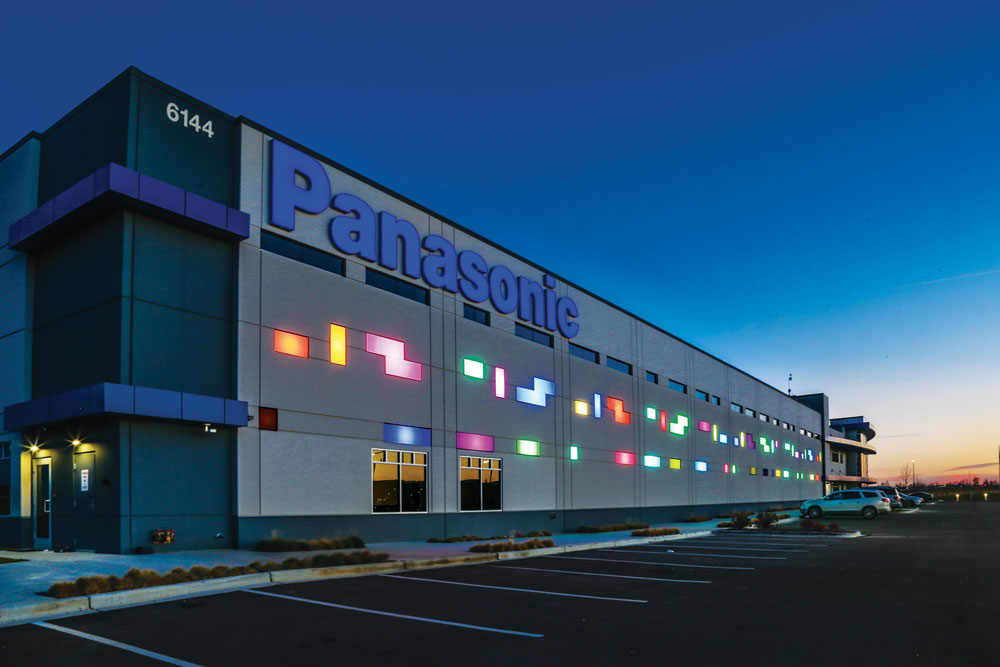
Panasonic’s operations hub for a new business unit focusing on “smart cities.”
Riding RTD’s A Line train from Denver to the airport, just past the 61st & Peña station, the view to the east is of a warehouse-looking building highlighted by pulsating colored lights and a big “Panasonic” sign. This is Panasonic’s one-year-old operations hub for a new business unit focusing on “smart cities.”

The 100,000-square-foot operations hub houses 30,000 square feet of office space, storage and testing areas.
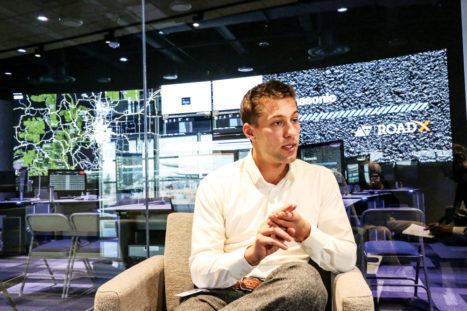
Peter Jacobson, a “Sustainability Consultant” with Panasonic, sits outside a mock-up control room being used to test a “data ecosystem” between vehicles and traffic management systems for CDOT’s RoadX program.
Panasonic Enterprise Solutions Company reflects the Japanese electronics giant’s shift in emphasis away from consumer electronics to a business-to-business and business-to-government focus. This new corporate direction began with the redevelopment of an obsolete factory site in Japan at Fujisawa into the world’s first sustainable smart town. Residents there rely on solar energy by day and fuel cells and batteries at night. Few
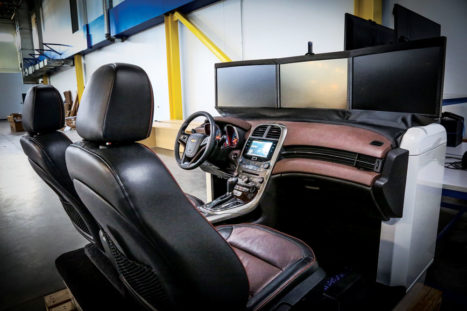
An auto “buck” for simulating the experience of driving an autonomous vehicle.
people own cars because public transit and shared vehicles are readily accessible.
Panasonic’s Peter Jacobson, who focuses on smart buildings and smart energy, says the scale of Panasonic’s projects will range from buildings to districts to corridors and cities. Since one company can’t provide all the technologies, Panasonic is positioning itself to be the “trusted partner” in planning and deploying systems for
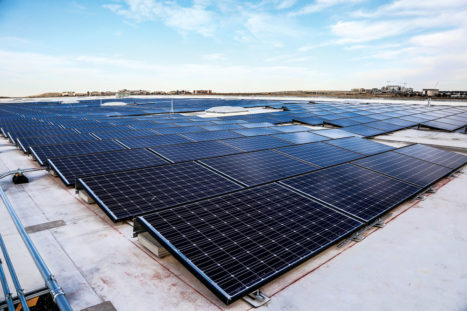
The roof-top solar array is 259kW using Panasonic’s high-efficiency HIT panels.
such large projects.
Denver out-competed 22 other cities seeking the new research facility because of the city’s “progressive reputation relative to technology and their strong commitment to regional collaboration,” says Jacobson. Indeed, Colorado has recently seen announcements of a number of new, high-tech projects. In mid-November, the Colorado Department of Transportation announced it will partner with

Peter Jacobson stands next to the batteries that help create a net-power positive micro-grid at Peña Station NEXT. The roof-top solar array is 259kW using Panasonic’s high-efficiency HIT panels.
Arrivo to test a high-speed transportation pod system along the E-470 corridor near DIA. This follows on the heels of the state’s selection in September as one of 10 “global” finalists in the Hyperloop competition to demonstrate the feasibility of an airline-speed vacuum tube transportation system.
One of the challenges, acknowledged Jacobson, is to bring Panasonic’s comprehensive approach to North America and translate it to Western values. For example, at the Fujisawa Sustainable Smart Town in Japan, the accepted balance between privacy and security may be different than in the U.S. To ensure safety, smart cameras there recognize people who live in the town, and those who don’t, are everywhere—an approach to security that may not work in a U.S. community.
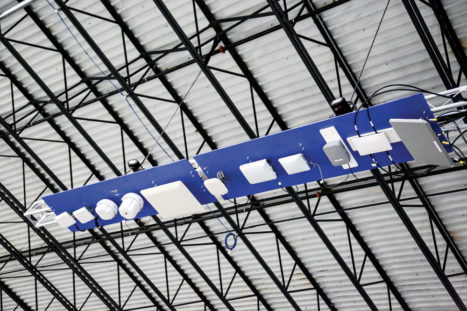
The photos above and below show the test bed for Panasonic’s high-density WiFi equipment.
Building a Smart City
The goal is to develop the 382-acre site, called Peña Station NEXT, into a local version of the Fujisawa smart city. A study to determine how the project can go from net power positive to become carbon neutral will be finished early in 2018 and will provide guidelines for developer L.C. Fulenwider Inc. to create a mixed-use community with residential, retail, offices, dining, hotels and parks.
dining, hotels and parks.
At Peña Station NEXT, Panasonic is the “major tenant and smart and sustainable general contractor for this living lab,” according to George Karayannis, executive director of Real Estate Development Solutions at Panasonic. He says the lab serves three purposes: “To vet emerging technologies, to validate the vendors, and most importantly, to create a business case for deployment of these technologies.”
Technologies under evaluation by the Panasonic CityNOW team include:
- A micro-grid merging solar panels with back-up batteries with a goal of energy self-sufficiency.
- Smart street lights that dim with increased ambient light and can flash in emergencies.
- Video-camera-based smart parking sensors.
- An “array of things sensor,” a small, beehive-looking device sometimes referred to as a “Fitbit for cities,” able to sense and measure many variables of interest to infrastructure managers, such as temperature, air particles (air quality), noise, humidity and solar cloud coverage. It can also count cars and people to help with parking and traffic flow.
- Electric vehicle charging stations.
- Autonomous electric shuttles with its partner EasyMile (see September 2016 Front Porch article frontporchne.com/article/a-glimpse-of-the-future/).
- Connected vehicle technology such as is being deployed as part of CDOT’s RoadX project.
- High-density Wi-Fi for use in settings such as stadiums and concert venues.
Future Activities
Future activities at Panasonic’s CityNow site will include:
- Deployment of an “interactive kiosk” at the 61st and Peña Station NEXT enabling users to get real time information on transportation, shopping, dining and emergency service options.
- Creation of a smart mobility test lab.
- Construction of a “Smart City Innovation Showcase,” an immersive main street to demonstrate all manner of smart city technologies in an intimate setting.
Jacobson says these technologies are organized around five “solution pillars” of activities at Peña Station, all preceded by the word “smart”: energy, buildings, living (emphasis on dwellings), streets and mobility.
Despite the whiz-bang appeal of the various technologies, Karayannis says the biggest challenge is developing the business models that allow for a profitable collaboration among many stakeholders. The micro-grid is a good example, requiring participation by not only Panasonic but key players such as Xcel Energy, Denver International Airport, the City and County of Denver, land developer L.C. Fulenwider, multiple hardware and software vendors and the National Renewable Energy Laboratory (NREL).
Beyond Peña Station NEXT
A Panasonic project with the Colorado Department of Transportation’s RoadX program may be able to reduce crashes by as much
as 80 percent and vastly increase roadway capacity, says Amy Ford, CDOT’s communications director. That project will determine the best way to communicate information about road conditions and the vehicles themselves to drivers and eventually to self-driving cars. Two options are being considered for this “statewide data ecosystem.”
One option is the use of existing cellular phone networks. This option, available through an app, may be deployed along I-70 between Golden and Vail as soon as this spring, says Ford. That service is being developed by HERE, a German-owned mapping and “real-time transportation data analytics” provider.
The second option, using Panasonic’s “roadside assistance units,” would create a fast, highly secure Wi-Fi network for communication between vehicles and sensors installed along the roadway. The roadside units, referred to as the Dedicated Short-Range Communications (DSRC) system, will begin field testing in two to three years.
The roof-top solar array is 259kW using Panasonic’s high-efficiency HIT panels.


0 Comments